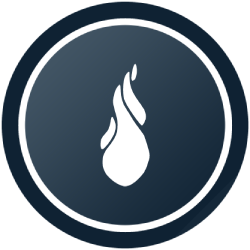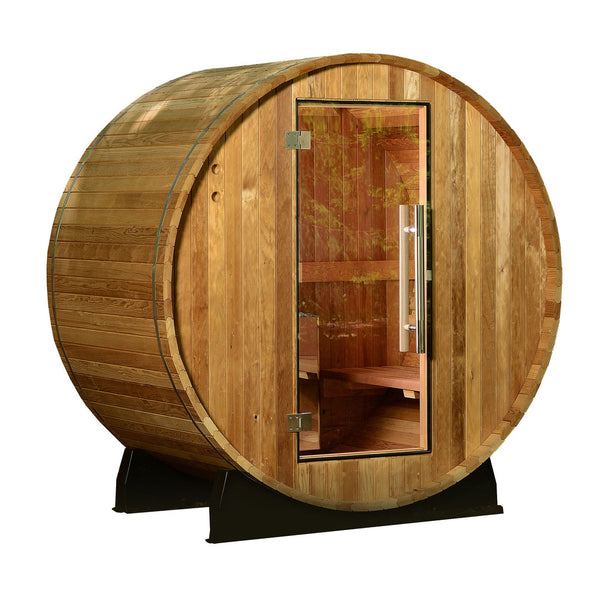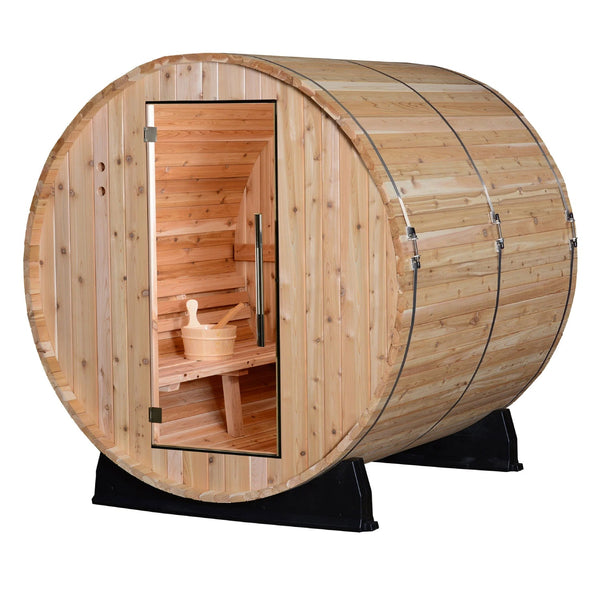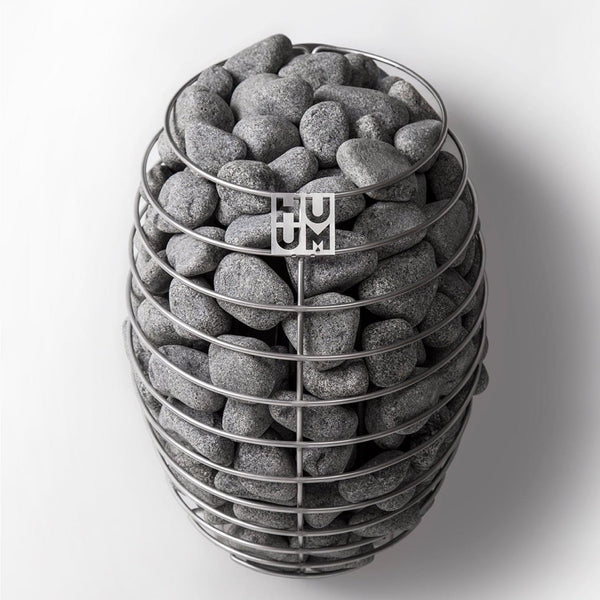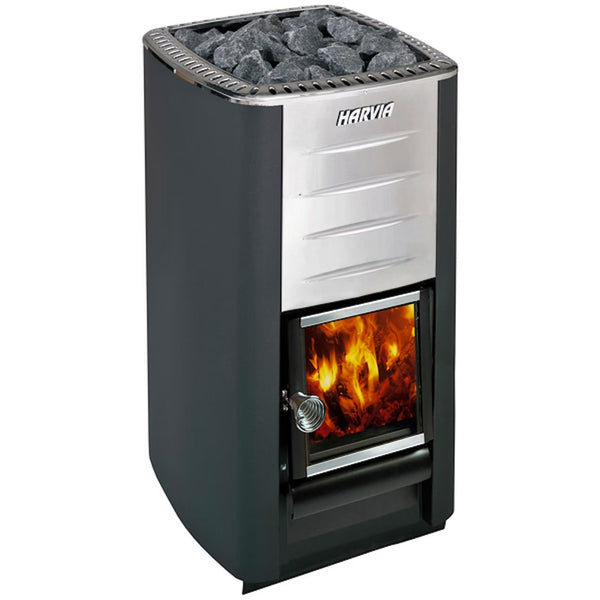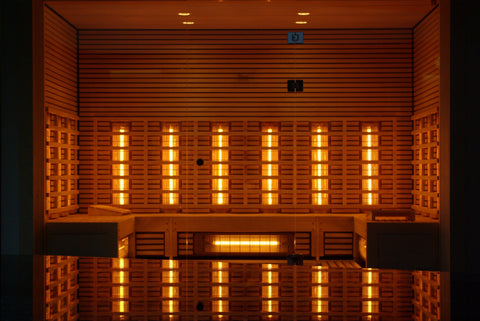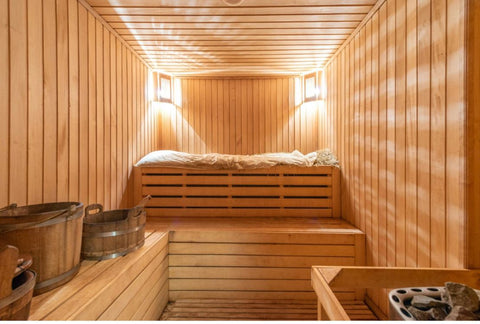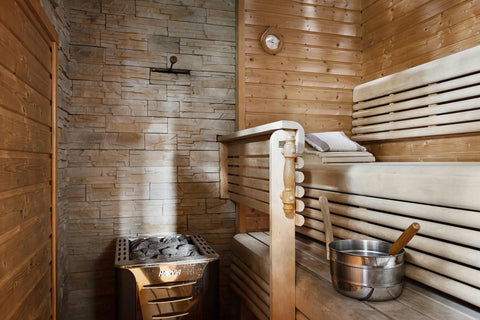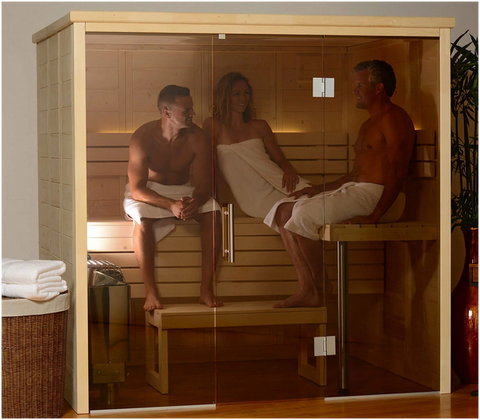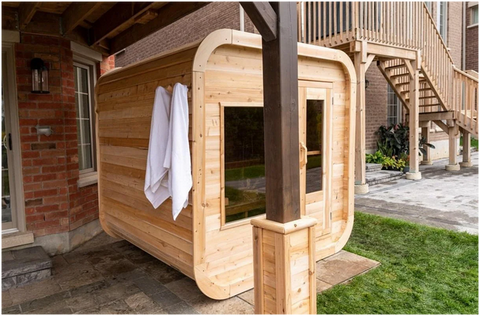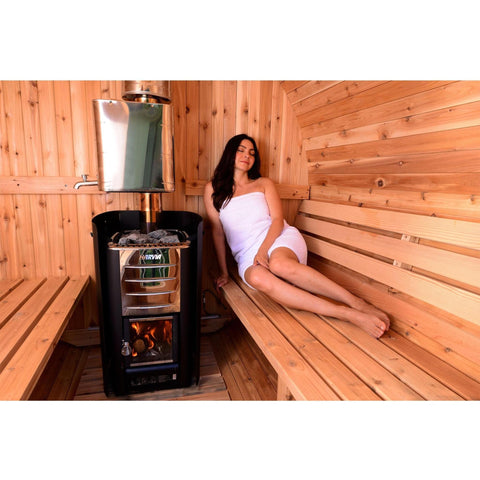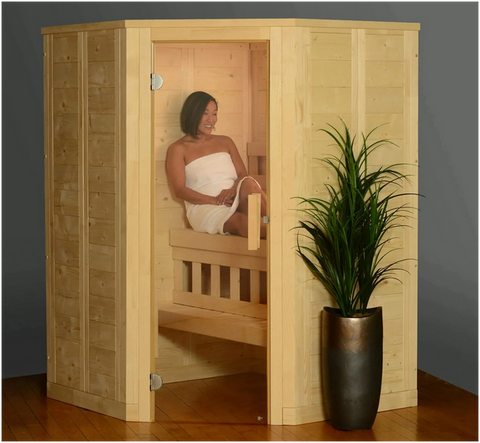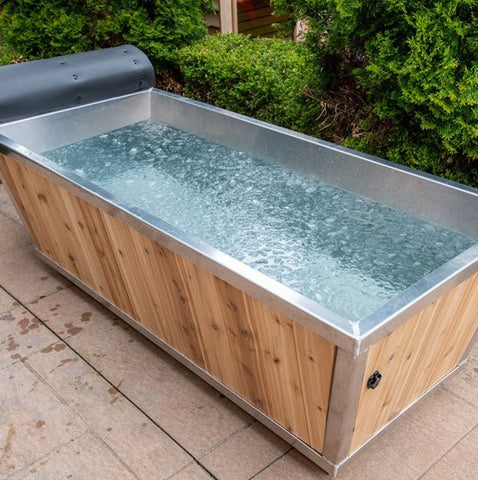Ask ten people how hot a sauna should be, and you’ll probably get ten different answers. Depending on the type of sauna, the best temperature for a comfortable experience ranges between 158°F (70°C) and 230°F (110°C).
However, sauna temperature is one of many factors affecting comfort and safety. One sauna might feel very different from another despite having the same thermometer reading. Factors like humidity and ventilation also contribute to the perceived hotness of a sauna, and we’ll learn why in a minute.
Public saunas usually operate at a narrower 158–194°F 70–90°C range, and steam rooms at 86°F (30°C) to 122°F (50°C). A private home sauna, on the other hand, lets you experiment with different settings and tailor the most delightful and relaxing sauna temperature for you.
Whether you already own a sauna or are thinking about getting one, the advice we’re about to share will help ensure you don’t misuse sauna temperatures. Plus, if you’re considering different types of saunas, we’ll show you which ones offer the best temperature control.
How Hot Can Saunas Get?
Most people know the average sauna temperature is about 175°F, but saunas can get much hotter. Traditional wood-burning saunas can reach 240°F (116°C) or higher, more than enough to cook pasta. If you’re not careful, extreme exposure to sauna heat can lead to heatstroke, burns, or even death.
In fact, the World Sauna Championships (1999–2010) were discontinued due to a fatality. People used to compete to see who could withstand a sauna heated to 230°F (110°C) for the longest time. Tragically, one man died in 2010 and another was treated for severe burns. This occurred despite careful preparation and strict rules.
So, while it may be exciting to push the limits of your sauna, don’t endanger yourself or others. Keep in mind that your body reacts differently to dry heat and humid heat, and getting the settings wrong could put your health at risk.
Heat and Humidity in a Sauna
A healthy person’s body maintains a core temperature of 98.6°F (37°C), allowing only small fluctuations of 0.9°F (0.5°C). When the air temperature exceeds 95°F (35°C), you start to sweat as your body tries to cool itself through evaporation.
In dry heat (air temperature above 90°F and relative humidity below 30%), sweat evaporates rapidly. This is a very effective way of cooling your body, but it also quickly dehydrates your body. In fact, if you’re not sweating in a sauna, it could mean you’re dehydrated.
In humid heat (relative humidity above 30%), the air is hot and moist, so sweat collects on the skin instead of evaporating. Your body finds it difficult to cool down, which can lead to dangerously high core body temperatures. Humid heat is the type you would feel in a tropical rainforest.
Humid heat is dangerous even at lower thermometer readings. That’s why a wet sauna shouldn’t exceed 120°F in normal operation, while a dry sauna can safely go as high as 195°F (90°C).
Best Sauna Temperature and The Rule of 200
Wood-burning and electric saunas can be used as either dry or wet saunas, depending on how much water is poured on the hot stones to create steam. The "rule of 200" is a guideline for maintaining safety and comfort by balancing temperature and humidity.
According to the rule of 200, the sum of your sauna temperature and humidity readings shouldn’t exceed 200. For example, if your sauna is set to 170°F (76.6°C), the humidity level should be around 30%. Similarly, a temperature of 160°F should correspond with a humidity setting of 40%, and so on.
The rule of 200 ensures comfortable sauna sessions, but it's not perfect. In practice, you wouldn’t set your temperature to 200°F as it's impossible to have zero humidity. Also, there's no rule saying you can't exceed 200°F. Use the temperature that you prefer.
Ideally, the best temperature for a dry sauna is 170°F-200°F to maintain safety and comfort. Experienced sauna lovers may tolerate higher temperatures, but going further beyond 200°F isn't to everyone's liking.
The table below shows a summary of ideal temperature ranges for various saunas.
|
Type of Sauna |
Ideal Temperature Range |
Notes |
|
Traditional (Finnish) Sauna |
167°F–221°F (75°C–105°C) |
Creates dry heat, which can become more humid when water is thrown on hot stones (creating "löyly"). |
|
Infrared Saunas (Far Infrared and Full Spectrum) |
120°F–140°F (50°C–60°C) |
These focus on direct heat absorption despite lower air temperatures. |
|
Steam Room |
110°F–120°F (43°C–48°C) |
High humidity (100%); feels hotter due to the moisture. |
|
Wet Sauna (which is really just a term for a dry sauna with water poured over the stones) |
170°F–190F (77°C–88°C) |
This is the “normal” sauna experience in the US. (In our opinion, slightly too cold!) |
|
Russian Banya (a type of steam bath) |
140°F–158°F (60°C–70°C) |
A mix of dry and steam heat; often uses water on hot stones for steam. |
Ideal Temperature for Infrared Saunas
Infrared saunas function differently than traditional saunas. Instead of heating the air around you, infrared heat penetrates your body directly, allowing your core temperature to rise without the need for extremely hot air.
Home infrared saunas typically reach 120°F to 140°F, which feels cooler but still provides deep heat therapy. By the way, infrared heat is the same kind you feel on your face when the sun is shining, or from a coal fire. The sun warms the ground and us, but not the air above us.
The advantage? Infrared saunas are more energy-efficient, heating up faster and using up to 80% less energy than electric saunas. However, they don’t produce steam, so if you’re looking for that classic wet sauna experience, infrared might not be your best bet.
If you’re shopping for a private home sauna, check out our three most popular models below.
|
Dynamic Saunas Barcelona 1-2 Person Low EMF FAR Infrared Sauna |
SaunaLife Model EE8G Sauna Barrel |
|
|
|
|
|
|
Finnmark FD-5 Hybrid Full Spectrum Infrared 4 Person Sauna
|
|
Sauna Temperature Control
Modern electric saunas offer a high degree of precision and ease of use. With a simple dial or digital control panel, you can set and maintain your preferred temperature without worrying about feeding a fire.
Some electric saunas even allow you to preset sessions, so the sauna reaches your desired temperature before you even step in. For example, the luxurious SaunaLife Model G6 outdoor home sauna paired with a Saunum AIR 10 heater comes with 3 preset sauna settings. You can even connect it to your home internet and schedule sessions from your phone.
The ability to control the heat and ambiance so accurately makes these saunas very popular, allowing you to fine-tune each session for comfort or specific health benefits. While electric sauna heaters may not have the rustic charm of wood-burning models, their convenience and consistency make them a favorite for home use.
Temperature Control in Wood Burning Saunas
Traditional saunas heated with a wood-burning sauna stove offer a hands-on experience but with less precise temperature control.
Since you’re dealing with an open flame, you have to manually adjust the temperature by adding or removing wood and controlling airflow through vents. Pouring more water on the rocks helps to lower the temperatures, although it also increases the humidity levels.
While it’s more challenging to maintain an exact temperature in a wood-burning sauna, many sauna lovers appreciate the authenticity and ritual of tending the fire and throwing water on the sauna rocks. Traditionally, Finns soak a bundle of birch branches in the water before pouring it over the stones to create a deliciously scented steam (löyly in Finnish). This is believed to have healing and rejuvenating properties.
The scent of burning wood and the uneven heat distribution create a unique atmosphere, but for safety, you’ll need to keep an eye on the thermometer to avoid overheating the space.
Temperature Control in Infrared Saunas
As we have discussed, infrared saunas heat the body directly. Since the air isn’t as hot, infrared saunas are more comfortable for longer sessions, and they don’t require constant adjustments to the heat settings.
Our luxury infrared saunas come with digital controls, which include options for light therapy (chromotherapy) and music integration for added relaxation. They also warm up much faster, usually needing only 10–15 minutes compared to 45 minutes or longer for traditional saunas.
Additional Tips on Sauna Safety
When using a traditional sauna, remember that humidity and ventilation are also for safety. A properly ventilated sauna maintains even heat distribution and prevents the space from feeling too stifling.
Opening vents slightly can reduce humidity and help cool down the sauna if it gets too hot while closing them traps heat and moisture for a more intense experience. Proper airflow helps regulate both temperature and oxygen levels, ensuring you don’t overheat or feel suffocated during a session.
Ventilation is even more important in a wood-burning sauna to prevent suffocation. Here are a few more tips to help keep safe in the sauna.
-
Limit time in the sauna: Although heat exposure in a sauna is hugely beneficial, don’t stay longer than 20 minutes in a traditional sauna
-
Avoid alcohol and drugs: These can make it more difficult for your body to maintain blood pressure in a sauna
-
Don’t eat a large meal before a sauna: It causes the body to reroute blood flow to the trunk, which most people find uncomfortable
-
Stay hydrated: you can lose up to a pint of sweat in a sauna, causing dehydration and lightheadedness
Finally, take some time to cool down and relax after your sauna. Let your body cool gradually, which helps regulate your heart rate and enhances relaxation, especially in the evening when you need to wind down before bed.
Verdict: How Hot Should a Sauna Be?
Saunas are a fantastic way to relax, detox, and improve circulation, but temperature control is key to making sure the experience is both enjoyable and safe.
The ideal sauna temperature depends on your preference and the type of sauna. For a traditional Finnish sauna, aim for 158°F to 195°F (70°C to 90°C) for a balanced experience. If you're using an infrared sauna, 120°F to 140°F (50°C to 60°C) is more typical, as the heat penetrates deeper without raising the air temperature as much.
We encourage you to experiment with the temperature and humidity levels in your sauna but stay mindful of your limits. Always listen to your body, stay hydrated, and don’t push yourself beyond your comfort zone. When in doubt, stick to the recommended settings and enjoy safe, happy sauna sessions.
